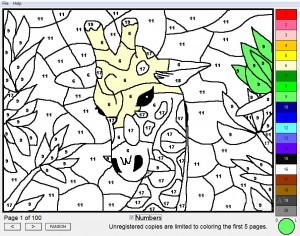A car trip to the airport with my older “Hanai” son Jim today led to my ruminating about the joy, struggle, and emerging clarity about trying to design and implement real-world learning for mathematics and science in my MPX 10 classroom. In trying to explain the difference between traditional pedagogy and constructivist, learner centered environments, I was trying to come up with a metaphor for why so many students think they’re not mathematicians, when conversing with them makes it clear that they are clearly mathematical thinkers, but they don’t fit into traditional mathematical (or science for that matter) classrooms. As I was trying to come up with a way to differentiate this struggle I am having, it occurred to me that one analogy/metaphor that worked for me (your mileage may vary) was the difference between painting by numbers, and creating art.
Imagine a classroom where the goal of the classroom was to fill out increasingly more difficult paint by number drawings, each one very prescriptive in both how to do it, and what the outcome should look like. Cognitively, the student requires very little effort to accomplish the task, and at the and they have a piece of art that more than not looks like the learning target that was intended. The assessment wouldn’t be the quality of thinking that went into the artwork, but more a case of how well they match filling in the shapes neatly inaccurately according to the schematic in the plan. An example might look something like this:
(from http://www.davidkhurst.com/wp-content/uploads/2013/09/FRS-Paint-By-Numbers_1.jpg)
Think about a classroom that would use this as a means to teach kids about art – everyone would be clear about what they were “learning”, assessment would be a process of conformity – no allowed color changes or going outside the lines and if you don’t cause trouble, you have to do very little real thinking. You might think yourself “why can’t I create these instead of do someone else’s”, but that’s not the goal of the class, is it? And ultimately, if you were to ask a student to paint an elephant or even more heretical she paints something of their own idea, they would not really know how to even begin to take into account color, shading, perspective, foreground and background, or any of the other things that are part of an artist’s repertoire of thinking, habits of mind, and tools. If a student were to become an artist, it would likely be in spite of their experience, not because of it.
I am struck by the sense that much of what we do in math and science education has a fairly direct corollary. The work we do in math and science classrooms, at least the ones that I attended when I was in school, and that I still still think are fairly prevalent in most students’ experiences is a paint by number approach. The unit of instruction starts with more than not a particular kind of problem or learning target (we are going to learn Newton’s Laws, we are going to learn how to find the slope of the line) and then the approach is a very linear sequential already mapped out method to get to the intended answer – the giraffe. This would be fine if the goal was to teach kids how to do math or science by numbers, but I’d venture to guess that it does little to create a sense of being a mathematician or scientist, and does not engender a sense of action, engagement, or application of any of the ideas, because they are not connected to anything but the painting with the numbers itself.
In our science department meeting in thinking about how we are going to implement next-generation science standards (NGSS) one of the ideas we agreed on was the importance to move from science facts – memorization and shallow learning to having students involved in more of the process of learning and bringing engineering into the work so they understand how what they’re learning can be applied. One of my colleagues mentioned that research shows that as students move from elementary to middle and high they begin to move away from their curiosity and the number of questions they can generate about phenomena and instead start to just become task oriented around lower-level work. Ken Robinson tells this wonderfully in his books “Out of Our Minds” and “The Element”. If our classrooms are paint by number classrooms, it’s hard to imagine that we would create any other condition than this.
If we want to create artists, we can’t do paint by number, we need to have students develop the eye, the mindset, the language and the work of real artists. In much the same way, in our math and science classrooms, we need to re-think and purpose our energies around creating classrooms in which we don’t give students work sheets or repetitive problem sets, which are the equivalent of paint by numbers, but instead design and challenge our students to investigate, create, reflect, collaborate and implement artifacts that show the work of a mathematician or scientist. If our classrooms already have a fixed outcome and there is no energy, creativity and even mystery around what we might end up with in the process of exploring our field of study, then we are doing no better than paint by numbers.
All of this thinking made me remember a marvelous song by Harry Chapin that I’ve known for over 30 years, but just came back into my thinking while I was ruminating about this issue in my classroom and everyone’s learning environment.
If you’re not familiar with it, I hope you find it is relevant, sad and insistent about re-thinking our classroom environments as he intended it to make us consider over 40 years ago.

